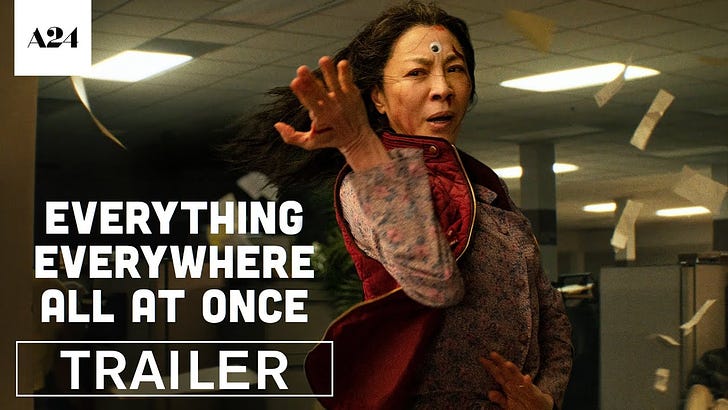There’s a certain structure to multiverse stories: We begin in a fallen world. Maybe it’s not even that terrible, but something isn’t the way it could or used to be. The hero is often an ordinary person, like Evelyn in Everything Everywhere All At Once (played by Michelle Yeoh, who is perfect). Evelyn’s life is full of humanity and clutter and friction. Endless piles of receipts, bags of customers' laundry stowed up high on shelves, noodles to cook, customers with yappy dogs. When you imagine someone able to skate between possible worlds and selves, you wouldn’t think of Evelyn—her life is held in place with so much stuff.
And yet, in multiverse stories, the hero’s seemingly ordinary qualities are exactly what make them the Last Hope. In order to save the world, they’ll have to transcend whatever resistance has been holding them in place, but by virtue of their humble experience in so-called regular life, they’ll also prove equal to the meta task of saving the multiverse from a villain whose imperative is to shrink experience down into something controllable. In this case, all of Evelyn’s failures are what make her the hero: because she chose the bleaker road at every turn, she’s paradoxically the closest to a breathtaking array of extremely successful, skilled Evelyns. In multiverse stories, living your worst life isn’t the worst thing that can happen.
One of my favorite things about the world building in Everything Everywhere All at Once is that, in order to jump between universes, you have to first do something which, in your present world, is as unlikely as possible, inducing a kind of probability wobble which allows you to unstick yourself from your reality and be sligshot into another one.
The next structural element of a multiverse story is the exploration of just how massive and various the multiverse is. There’s a necessary absurdity to this—how else are you going to express the narrative potentiality if not by introducing worlds where humans evolved to have hot dog fingers alongside the more conventional alternate-world hypothesis of a universe where the ordinary person is an A-lister in a gown?
By way of this exploration, we finally meet the villain, someone whose world-jumping fluency is unparalleled and kind of terrifying. The villain is planning something which threatens to collapse all of the worlds, and there’s usually something nihilistic about this. That’s where the hero’s ordinary experience comes in handy; there is something about regular old lived reality which acts as an antidote to the heady kind of binary logic that takes over. Multiverse plots often end up affirming the beauty of what is, as it is. In other words, they are love stories.
(This is where I’m going to stop describing the movie, because I really think everyone should just see it with as little preemptory information as possible.)
I have a few theories about why multiverse stories are everywhere at the moment. For one thing, I think everyone can be forgiven for wondering if there really is something a few shades too wrong about our world. The last few summers, I’ve thought that the sun felt a little bit meaner than it used to—just more crackly and malevolent. To say nothing of the news cycle or online discourse, etc. etc. Also, I think multiverse stories might be a roundabout way of approaching the fear of an AI singularity—both outcomes involve trying to understand the existence of boundless connectivity and a logic outside human scale. The multiverse story always contrasts that massiveness with a humble human, and we need a new story to tell about ourselves.
Among many other things, the multiverse story is also an antidote to the trauma plot.
Antidote is kind of a spicy word choice, but I mean it. Tune in tomorrow and I’ll tell you why!
X
S



